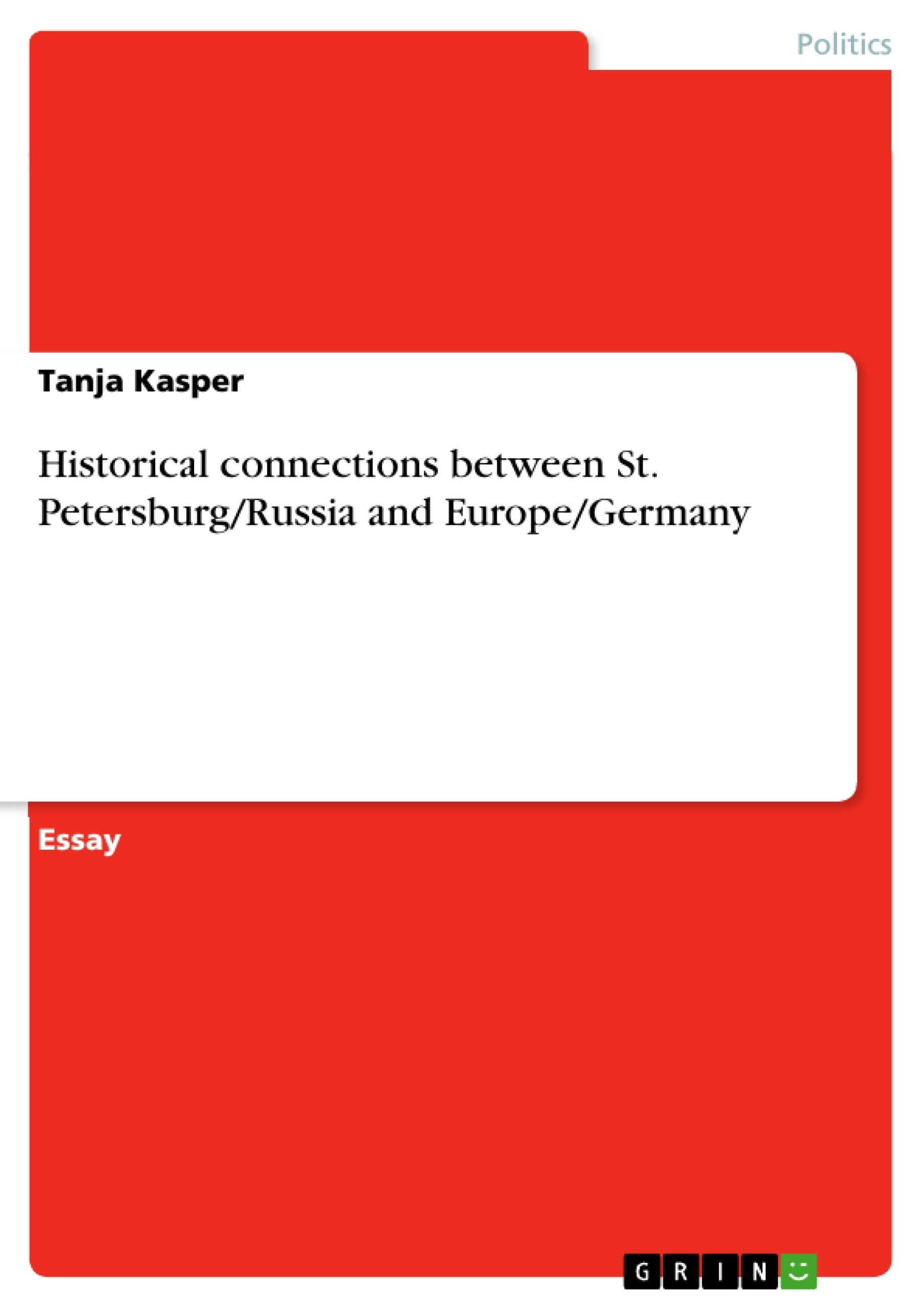Excerpt
Content:
A Introduction
B Main Part
1. Peter the Great
2. Vladimir Putin
3. Differences
C Summary
A Introduction
“St. Petersburg – Russian’s window to Europe”
you can read in almost every information about the city.[1] But besides being the biggest city in western Russia and an important access to the Baltic sea it has also some important ‘personal’ relations to Europe or e.g. Germany:
Peter I the Great and Vladimir Putin.
One, the famous founder of St. Petersburg in 1703, who moved the capital from Moscow to his new preferred location and thereby opened whole Russia to deeper relations to the West. The second one, the current Russian president who aims to lead his country with his immense power more and more to become one of the big global players in other/more aspects than in former times. So both have close biographical relationships to Europe or European countries and through their power as heads of the country, this in turn has been influencing Russian culture, politics and business. On the basis of these St.Petersburg characters I would like to identify some hints for a ‘Westernization’ of Russia (through St.Petersburg) in Detail.
But simultaneously important separating factors shall be mentioned which causes still more reluctant behaviour from companies towards Russia.
After all I have to add something crucial about the resources I used. It was surprisingly for me to discover that there are only sparely reliable information about Russian topics in the internet available. So I had to reduce my sources mainly to Wikipedia and my St.Petersburg Travel guide Vis-à-Vis[2].[3] I tried at least to re-check the information in e.g. comparing the articles of Wikipedia between different languages and other links I found. But still there is perhaps a lack of the scientifically demanded variance and acceptance of used sources.
B Main Part
1. Peter the Great
Born 1672 in Moscow Peter had to become a witness the butchery of parts of his family in his childhood because of a dispute about the future regency. Some assume that this was one of the reasons why Peter turned his back to Moscow. After becoming the sole ruler on the Russian throne it is said that he was highly influenced by western advisors who affected him to dream about leading Russia to become a maritime power. In searching aid against the Ottoman Empire he travelled in 1697-1698 incognito with a large delegation to Europe. Nevertheless, after realizing that this aim could not be reached they continued their Europe-discovery in visiting England, the Holy Roman Empire and France. Here, Peter studied shipbuilding, artillery and learnt consequently much about Western culture.
Consequences of this trip were e.g. that a Dutch-Norwegian man became his most important advisor in maritime affairs. Furthermore he commanded all of his courtiers and officials to cut off their long beards[4] and wear European clothing in the belief that European customs were in several respects superior to Russian traditions. Peter even changed the Russian year to the Julian calendar.[5]
Whole St. Petersburg architecture was inspired or even created by European artists. E.g. the Kazan Cathedral was strongly oriented at the St. Peter’s Basilica in Rome. One other architectural example and a huge symbol of Peter’s European orientations is also Peterhof – build on the Model of Versailles. But not only in the sense of its architecture - later on when Anna, a niece of Peter took, acceded the throne she decided to turn Peterhof into a centre of royal lifestyle like in a typical European style at that time. She spent most of her life in Germany and chose most of her minions and advisors from there. And also her followers as e.g. Peter’s granddaughter Catherine continued the ‘Westernization and Modernization’ of Russian culture in promoting education and Enlightenment among the elite. “Not only as an autocrat, but also as a writer, journalist, and its loudest propagandist and kept up a correspondence with many European figures of this movement.”[6]
[...]
[1] E.g.: Travel guides as Vis-à-Vis, Wikipedia or other tourist information.
[2] Vis-à-Vis: St. Petersburg. Dorling Kindersley Verlag GmbH, München. 2005
[3] When using this sources I don’t mention them in the footnotes separately.
[4] There was even a special tax of one hundred rubles for Boyars, which were sought to retain it.
[5] Unfortunately just at this time Europe moved to the Gregorian calendar but Russia kept the Julian calendar until the October revolution in 1918.
[6] Found 18.05.06 http://encarta.msn.com/encyclopedia_761559802/Catherine_the_Great.html
- Quote paper
- Tanja Kasper (Author), 2006, Historical connections between St. Petersburg/Russia and Europe/Germany, Munich, GRIN Verlag, https://www.grin.com/document/58860
Publish now - it's free






















Comments